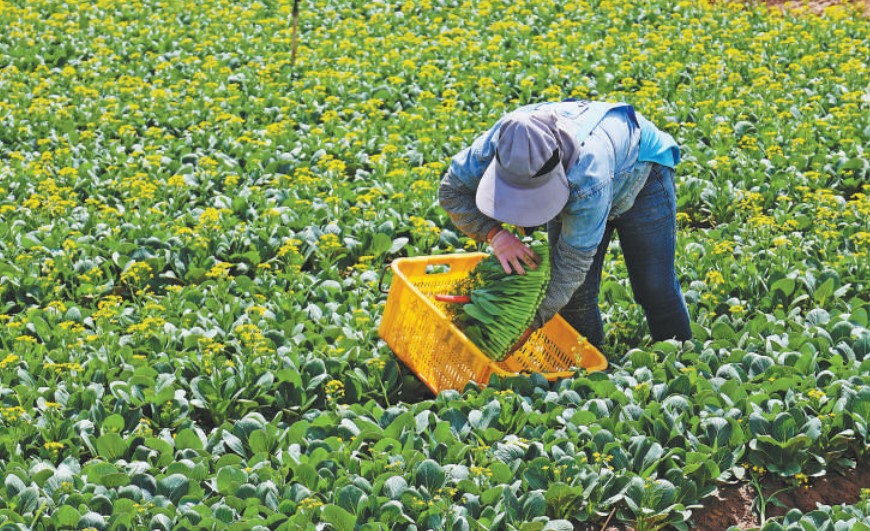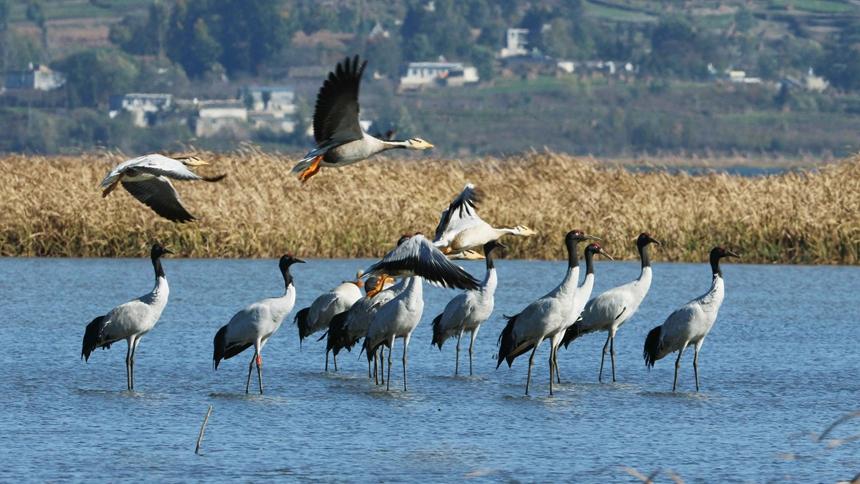Ningxia-grown vegetables find big market in Greater Bay Area
In a vegetable planting base in Xianjin village, Ligang township, Helan county, Yinchuan, northwest China's Ningxia Hui autonomous region, which mainly supplies its produce to the Guangdong-Hong Kong-Macao Greater Bay Area (GBA), Chinese flowering cabbages were just harvested, and they would soon be shipped to Guangzhou, south China's Guangdong province around 2,300 kilometers away.
"It takes only 36 hours for our Chinese flowering cabbages to reach the markets in the GBA from our fields. The demand is so high that we can hardly satisfy it," said Chen Dingyou, head of the planting base. Chen works for an agricultural technology company in Ningxia that owns vegetable distribution centers in three cities in the GBA.

A worker harvests Chinese flowering cabbages in a vegetable planting base in Helan county, Yinchuan, northwest China's Ningxia Hui autonomous region, which mainly supplies its produce to Hong Kong. (People's Daily/Qin Ruijie)
Chinese flowering cabbage is a vegetable commonly used in Cantonese cuisine. In Helan county alone, there are 15 planting bases that grow it, covering a total area of 24,500 mu, or about 1,633 hectares.
The Chinese flowering cabbages harvested in Ningxia are shipped to the GBA through cold-chain logistics, and they enjoy high reputation in the region.
The unique climate is what makes Ningxia a perfect place for growing Chinese flowering cabbages. Take Helan county as an example. The county, with an average altitude of over 1,000 meters, has dry summers and enjoys rich sunshine. Besides, with the Yellow River as the source of irrigation, nutrient accumulation becomes easy for the vegetable.
Though Ningxia boasts sound natural conditions, science-based planting is still necessary. Standard planting techniques of GBA enterprises are now adopted in Ningxia.
Chen picked up his phone and showed how the vegetable is planted. In the vegetable field, neatly arranged ridges spaced 20 centimeters apart stretched across the land. The Chinese flowering cabbages glistened with water droplets as workers skillfully and swiftly cut the tender greens with precision.
Today, the vegetable base of Chen's company utilizes automated irrigation systems and drone-based crop protection operations, which have significantly reduced labor management costs.
With a simple tap on a mobile app, the 2,000-mu planting base was divided into dozens of plots, where details like seeding and weeding progress were displayed.
"We've developed a digital field management and monitoring platform that allows us to manage the entire planting process - seeding, fertilizing, and watering - all from a smartphone," said Wu Xiaoning, the materials scheduling manager of the company.
"Currently, processes like rotary tilling, seeding, and film mulching are all mechanized. The base can cultivate five full crop cycles each year, with each cycle yielding 400 to 600 kilograms. The average output value per mu for the entire planting cycle reaches 10,000 yuan ($1,379)." Wu added.
"The Chinese flowering cabbage grown using modern farming techniques has a crisp and tender texture," said Chen. "As soon as the product hits the market, it becomes a hot seller in the GBA."
Delivering delicious Chinese flowering cabbages to the GBA, more than 2,000 kilometers away from Ningxia, wouldn't be possible without a modern logistics system.
"The cold storage is maintained at 1.5 degrees Celsius. Once the freshly harvested Chinese flowering cabbage is brought in, it is rapidly cooled down," said Li Houxue, head of Xianfeng agriculture development company based in Ningxia, referring to a cold storage facility of the company.
After being pre-cooled for six hours, the Chinese flowering cabbage harvested is packed and sorted by 2 a.m. the next day. By 8 a.m., refrigerated trucks set off directly for Guangzhou, where the produce is distributed to secondary centers in cities like Guangzhou, Shenzhen, and Dongguan. Some batches, after passing quality checks, are loaded onto trucks bound for Hong Kong, ready to hit the local market.
"With professional cold chain logistics, the transportation cost for a 15-kilogram box of Chinese flowering cabbage has been reduced to just 15 yuan," Li said.
Today, nearly 80 refrigerated trucks depart from Ningxia every day, delivering Chinese flowering cabbages to regions like the Yangtze River Delta and the GBA. To address storage challenges at the source, Helan county has ramped up cold chain infrastructure development. Currently, 56 enterprises have established cold storage facilities with a combined capacity of approximately 89,900 tons and a net volume of 449,500 cubic meters. These advancements have greatly improved the storage, preservation, and processing capabilities for agricultural products at their origin.
To meet market demand, many vegetable bases in Ningxia that supply products to Hong Kong have established strict cultivation and quality control standards. They have developed a comprehensive industrial chain from planting, management, and harvesting to packaging, cold chain transportation, and sales.
"In 2023, Helan county's vegetable planting area reached 243,800 mu, with an annual output of 474,600 tons and a production value of 1.4 billion yuan. This has effectively boosted employment and income for local farmers," said Chen Ying, director of the bureau of agriculture and rural affairs in Helan county.
Photos
Related Stories
- One-year countdown to China's 15th National Games marked in Guangdong
- China's Greater Bay Area marks one-year countdown to National Games
- Greater Bay Area cultural heritage forum explores new paradigm of interconnection
- Bridging cultures: Documentary "Touching the Greater Bay Area" launched in London
- GBA embraces greater tax coordination with MoU signed in Hong Kong
Copyright © 2024 People's Daily Online. All Rights Reserved.









